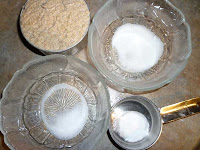Sourdough Discard Crumpets
Today I joined the Bread Technique Forum, where a lot of people who bake Reinhart's recipes seem to congregate to share ideas. There is a lot of information there, and as a Newbie I have a lot of browsing to do just to get caught up.
One posting in particular caught my eye, because today I am once again refreshing my sourdough. Someone was asking others what they do with their sourdough discards. One suggestion pointed to the King Arthur Flour Kitchens, where they suggested spent sourdough would make good crumpets.
As previously mentioned, I have been refreshing my motherstarters about 2X a week, in the following ratio:
- 73 g motherstarter ( ~1/2 cup)
- 218 g flour (either whole wheat or rye) (~ 1 2/3 cup)
- 166 g water ( 3/4 cup)
My Motherstarters: Whole Wheat and Rye.
The Whole Wheat remnant is 1 1/2 cups.
So crumpets it is:
Ingredients:
- 1 c motherstarter
- 1 tsp sugar
- 1/2 tsp salt
- 1/2 tsp baking soda (Neutralizes the acidity of the starter)
Directions:
Add sugar, salt and baking soda to the motherstarter and mix.
Preheat an oiled skillet over low heat, and then fill an oiled metal baking ring with 1/4 inch of batter.
When the tops are set and full of holes, remove the rings and flip the crumpets to the other side for a minute or two. Stockpile them and pop them in the toaster before eating (or freeze what you don't use).
Serve with butter and jam.
When I tried this, I was feeling that the sourdough was going to be too firm, so I had some water ready to add to it. After adding the baking soda, I noticed some loosening of the firmness, but I went ahead and added a Tablespoon of water. And I think that this was a mistake. I think if I had waited another 30 seconds, the baking soda would have provided the chemistry to make this the appropriate consistency.
The dough sort of ran a bit more than it should have. It did plump up like a pancake, but I didn't get the true crumpet holes. The first one I tried burned a little (the heat was on too high). The rest seemed a bit runny.
The recipe made 4 'crumpet things', but you can see that I had some trouble regulating the heat.
I still had 1/2 a cup of motherstarter discard, so I decided to just try frying that up 'as is', without adding any sugar, salt or baking soda.
The taste of the direct motherstarter was quite sour, but not unpleasantly so (to my taste); the baking soda versions with sugar and salt had not a hint of sourness, as promised.
The two that were made directly from the motherstarter were a bit puffier, but they were gooey inside, moreso than the baking soda versions. But even they needed to be toasted to get the middle cooked too.
I didn't try this with the rye motherstarter right away because I got tired and decided to sleep. The crumpets are not hard to make (not that I've mastered it) but they do take some time, cooking on low heat.
---
The next morning I fried up the batch of rye. The rye motherstarter had been sitting out all night and now it was at room temperature to begin with, and was activating on its own. I added no water, just the sugar, salt and baking soda to the entire 1 1/2 cups I had sitting there. I used no metal ring this time. It plumped up fairly nice -- although I'm still not using the electric frying pan, which would give me better control over the heat source I think. They look fine, and are not as flat as the ones I made the night before. But still, they are little more than a pancake, not quite a Crumpet, not quite an English Muffin.
They taste fairly blah. I detect a bit of sourdough tang in these, perhaps because I didn't scale the baking soda to this volume.
I wonder if you can bake these things, rather than fry them? I am thinking that the dough has to be handled more gently if it is to retain those fluffy airy holes built by the baking soda. I suspect that this is the purpose of the metal ring, so it fluffs upwards and not outwards. Or perhaps the timing has to be perfect, so that it hits the heat just as the bubbles form.
I might try these again. But I'll have to do something differently.
Notes to Myself:
- Try this again without adding water to the mix. Trust the baking soda to make the carbon dioxide bubbles that are usually made by the yeast.
- Try these in an electrtic frying pan to get the temperature well-controlled.
- Make certain that the bubbles are complete on the top before trying to turn these things, or you will have trouble.
- Don't bother with the metal baking rings, the dough will always stick to them no matter how much oil you put on the metal. Make them 'free form'.
- Think of ways you could bake this: perhaps the entire dough on a preheated baking stone: then you could cut it apart later, even using a muffin or cookie cutter to make them round. Would that work?























No comments:
Post a Comment